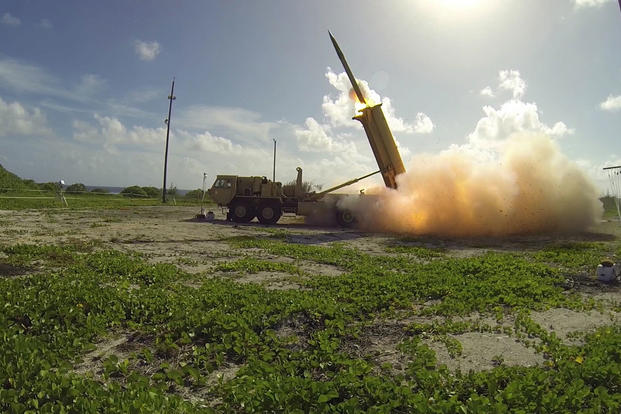The THAAD anti-missile launchers that have prompted condemnations from China and threats from North Korea could go operational in South Korea next month, according to South Korean officials.
Army Gen. Vincent Brooks, commander of U.S. Forces-Korea, said in a statement that the U.S. is moving "as quickly as possible" to put the "hit-to-kill" Terminal High Altitude Area Defense system in place. South Korean military officials said the system could be functioning by April, the Yonhap news agency reported.
An Air Force C-17 Globemaster III transport aircraft delivered the first elements of the THAAD system to Osan Air Base, about 43 miles south of Seoul, on Monday, shortly after North Korea launched at least four medium-range missiles that fell into the Sea of Japan -- within Japan's exclusive economic zone, the Pentagon said.
The missile launches were seen as a response to the ongoing Foal Eagle military exercises by the U.S. and South Korea that North Korea views as a practice run for an invasion.
"The timely deployment of the THAAD system by U.S. Pacific Command and the secretary of defense gives my command great confidence in the support we will receive when we ask for reinforcement or advanced capabilities," Brooks said.
Adm. Harry Harris, head of U.S. Pacific Command, reiterated the opportune timing in a statement Tuesday. "Continued provocative actions by North Korea, to include yesterday's launch of multiple missiles, only confirm the prudence of our alliance decision last year to deploy THAAD to South Korea," he said.
U.S. and South Korean officials have stressed that the THAAD deployment is a defensive measure, but China condemned the move as a provocative act by the U.S. intended to upset the balance of power in the region.
"China firmly opposes the deployment of THAAD," Chinese Foreign Ministry spokesman Geng Shuang said at a briefing Tuesday. "We will definitely be taking necessary measures to safeguard our own security interest. All consequences entailed from that will be borne" by the U.S. and South Korea.
China also used an editorial in the Global Times, a tabloid published by the Communist Party's "People's Daily," to rebuke North Korean leader Kim Jong-un on the THAAD deployment.
"By firing four missiles at once this time, the military confrontation between Pyongyang, Seoul and Washington escalates a notch," Global Times said. "Noticeably, the Chinese public is angry that Pyongyang's nuclear program has provided an excuse for Seoul to deploy THAAD."
A THAAD battery normally consists of six truck-mounted launchers, 48 interceptors (eight per launcher), a fire control and communications unit, and an AN/TPY-2 radar.
The THAAD systems are slated to be set up on what had been a golf course owned by the Lotte retail conglomerate in rural Seongju county, about 184 miles south of Seoul.
-- Richard Sisk can be reached at Richard.Sisk@Military.com.


























